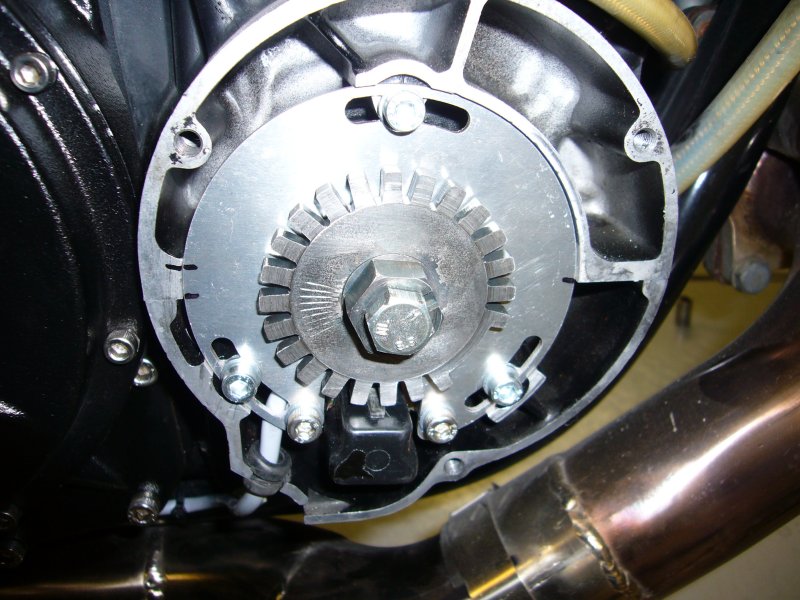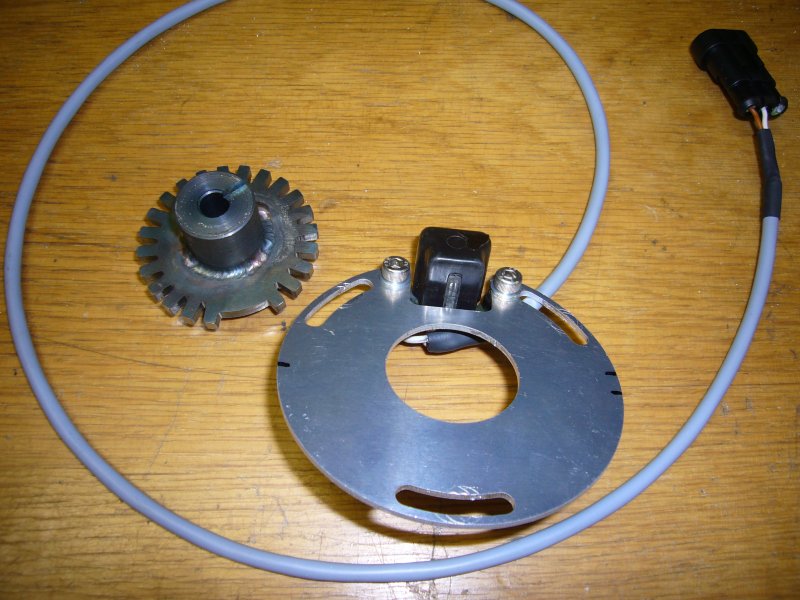

Arttu
-
Posts
903 -
Joined
-
Last visited
Content Type
Profiles
Forums
Events
Posts posted by Arttu
-
-
So you are getting more free play in the lever when the engine gets hot? Doesn't sound normal and I don't think it's because of the EBC plates. Unless the plates get badly warped when they heat up. One possible reason could be if the clutch shaft gets more axial play when warming up but I don't know why this would happen...
The GSX clutch is pretty reliable and well behaving when in good condition. But for that simple device there are surprisingly many things that can be wrong. One often overlooked thing is checking straightness / flatness of all relevant parts. Especially the steel plates can be slightly warped even if they look good so better to check them against some really flat surface like thick glass. Even small warpage adds up when the plates are stacked up in the pack and then causes all kind weird behaviour. Also the pressure plate and bottom of the center hub can get distorted. Unfortunately it isn't too easy to check them.
-
 1
1
-
-
Sounds a bit strange indeed. Generally a clutch with HD back plate should be very durable. On the other hand you probably get more compression cycles during one circuit race than in several years of drag racing. But these work fine also in street use where they collect some serious running hours over the years. For example I haven't had any problems during last five years and maybe 20-30 thousand kilometers. Of course it has been mostly quite easy riding but I also use all 300hp on regular basis.
I'm still wondering if side load from the helical gears could affect to this. You are right that rivets should take the load but still... Do you mean that stock cranks are manufactured with better tolerances than what you can get from the crank builders? If I recall correctly the Suzuki specification for crank throw-out is 0.1mm and according the crank builder that I have been using stock cranks often exceed even that. He assembles the cranks within 0.05mm which should be good for pretty much everything.
-
I have been told that 28mm ID shouldn't cause any significant restriction below 400hp. I have that size on my GSX1100 and it outputs about 300hp. Compared to boost level, rpm and other engine details this seems to be quite good result and I don't it would gain much power with larger header size. However, this is a blow through system and I'm not sure if a draw through with longer header would be different. But for example Orient Express funnybikes (about 600hp) were using quite small headers back in the days, not larger than 28mm ID I would guess.
It would be interesting to compare different headers designs in dyno, indeed. Unfortunately it's rare to see this kind comparable test results anywhere.
-
A push fit like that is airtight like a sausage in a hoola hoop when boosted air pressure is involved. Stock installation is at atmospheric pressure ie. zero - throw 1 psi at it and it'll leak like a sieve! You may get away with a liberal coating of RTV in the groove and around the rubber flanges but its got to resist any movement liable to split it putting / taking the carbs off and on.
I'm using similar airbox rubbers on my plenum too. Seals just fine without any additional sealant. Though I also did grooves around the holes where the lip of rubber boot sits. Actually pressure inside the plenum just pushes the rubber against the plenum wall and makes it seal even better. So if the fitment is correct I think it will work fine. And it saves some space compared to stubs and silicone hoses alternative

-
 1
1
-
-
I am looking for the whole shebang for the AFR gauge, controller, sensor etc. was just looking for personal opinions.
Yer I think I may be using a bracket to hold the turbo up and probably a scavenge pump.
if not using the down pipes I was looking at using 2mm thick mild steel tubing for the manifold. Would that be suitable?
Yes, then the MTX-L would be my choice. Most likely.
2mm thick mild steel should be pretty fine. Quite popular material choice is water pipe and bends. If I recall correctly that has about 2.5mm wall thickness. It holds the turbo nicely and resists cracking really well.
-
If you are looking for an AFR gauge, not just wideband controller, then Innovate MTX-L is one good choice. Reasonably priced and watertight.
I wouldn't use stock headers for turbo manifold. Usually the bends aren't tight enough to get the turbo high enough for gravity drain. Of course this isn't important if you are going to use a scavenge pump any ways. In addition it's a good idea to use quite thick walled tubing unless you are going to build additional support to carry weight of the turbo.
-
Hi Arttu
ET crank so I guess that is small taper.
Hi. That's what I was afraid of as I have heard earlier that some GSX-R flywheels fit on the small taper cranks.
ET is that early GSX model with square headlight, right? Years '80-81 or something like that? I guess I will never learn those letter designations as they are less used around here
 Any way, large taper cranks appeared with "black engines" somewhere mid '82.
Any way, large taper cranks appeared with "black engines" somewhere mid '82. -
Also - were you starting with a small crank, or the later Big ended crank (EFE etc)?
That's I would like to know too

I'm watching this with great interest. Especially if the flywheel fits on the large taper cranks. Lighter flywheel with more charging output sounds tempting.
-
I would start By checking that MAP sensor calibration. If it is off it will screw all tuning. Like Slingy suggested the first thing to check is reading at atmospheric pressure. It should be about 100 kPa +- few kPa. Of course calibration may be still off even if atmospheric reading is correct but it's less likely.
What kind AFR values we are talking about at "rich" and "lean"? Anything between 12-14 should be good enough to run without hesitation. At low throttle you can aim for about 14 or as lean as it runs without hickups. Full throttle before boost should be around 13 and on boost around 12. As rule of thumb. Lean misfires usually start to occur when you go above 15 and rich misfires may start around 11. And if you are way too rich so that the engine misfires heavily then lambda usually shows something around 11-12 due to unburnt air.
-
Agreed. Looks like a nice clean solution. I helped with an install on an aircooled z and found we had to move the trigger wheel around to phase the missing tooth with fastest part of the cranking cycle to get a good tach signal for starting. Oil cooled motor's don't seem as bad for this.
Did you find similar Arttu ?
I usually place the first tooth after the missing one(s) around 60 deg BTDC but this is just old habit from Megasquirt 1 times as placement was less flexible with it. I haven't had much trouble with starting if there is enough teeth on the wheel. 24-2 has been working without problems on every engine by this far. 12-1 on the other hand seems to be on borderline on bike engines, it may work quite ok or be almost impossible to get started.
-
The plugs are NGK
DR9EIX iridium plugs, are they any good? The dyno operator recommended cooler plugs (10)...These should be fine, I think. I have been using 9 temp range Iridiums on my GSX for years without problems. About 1.2 bar maximum boost. If you are aiming for significantly higher boost then colder plugs could make sense. Any ways, your current plugs shouldn't cause this kind problems. Granted they are in good shape of course.
I suggest taking a data log from problem situation and trying to figure out from there what's happening. Usually that's the most efficient way to pinpoint problems.
-
Megasquirt ECUs are a good choice. I have been using different versions on my GSX for over ten years now and I know numerous other successful bike installations. You just need to pay some attention which variant you choose as "basic" versions aren't robust enough for bike use, IMO. Microsquirt is one good option for basic setups and for high end use MS3-pro would be nice option though a bit pricey. In addition there are some "unofficial" variants that are well suited for bike applications.
I have made some bolt-on trigger sets for air cooled GS/GSX engines. The set consists of 24-2 wheel, a VR sensor and mounting plate for the sensor. I can make more of these if there is interest.


-
 6
6
-

turbo/EFI setup
in Forced Induction
Posted
Ok, let's start. My GSX1100E '83. 1230cc, 9:1 compression ratio, IHI VF34 ball bearing turbo, water injection for charge cooling.
Engine Management: Megasquirt 3 based ECU, additional data logging by CAN bus IO Expander from Autotune.fi (EGT for each cylinder, wheel speed, acceleration etc.)
Ignition system: Sequential Coil-On-Plug, inductive, controlled by the ECU.
Throttle bodies: GSX-R600 2001 (38mm). Secondary butterflies removed, modified spacing, cable mechanism moved in the middle of the rack.
Injectors: Primary - GSX-R600, 280cc, Keihin. Secondary - 630cc Siemens Deka, on the back side of the plenum.
Ignition coils: Bosch 986221016 equivalent (Porsche 911 turbo etc.), home made ignition amplifier.
Fuel system: Walbro GSL392 pump (255l/h), Mallory pressure regulator, 2.5 bar base pressure (lower pressure to reduce current draw of the pump)
Here are a couple of dyno graphs. Black one was on 1.1 bar boost, blue one about 1.3 bar.